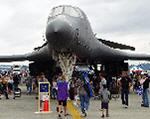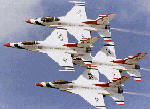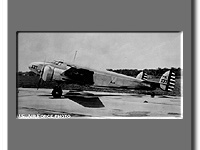
|
Description
| Manufacturer: | Lockheed |
| |
| Base model: | C-40 | ||
| Designation: | C-40 | ||
| Version: | A | ||
| Nickname: | Electra Jr. | ||
| Designation System: | U.S. Air Force | ||
| Designation Period: | 1925-1962 | ||
| Basic role: | Transport | ||
Specifications
| Length: | 36' 4" | 11.0 m | |
| Height: | 9' 9" | 2.9 m | |
| Wingspan: | 49' 6" | 15.0 m | |
| Wingarea: | 352.0 sq ft | 32.7 sq m | |
| Gross Weight: | 9,600 lb | 4,353 kg | |
Propulsion
| No. of Engines: | 2 | ||
| Powerplant: | Pratt & Whitney R-985-17 | ||
| Horsepower (each): | 450 | ||
Performance
| Range: | 800 miles | 1,290 km | |
| Max Speed: | 220 mph | 354 km/h | 191 kt |
| Climb: | 1,400 ft/min | 427 m/min | |
| Ceiling: | 22,900 ft | 6,980 m | |
Known serial numbers
Recent comments by our visitors
| Guy E. Franklin Deatsville, AL | The Lockheed C-40 was based on the commercial Model 12 Electra Junior. The Model 12 was essentially a scaled down version of the Lockheed Model 10 Electra. The Air Corps already had several Electras in service and designated them C-35, C-36 and C-37.
The Model 12 was designed initially as a small commercial airliner capable of carrying five or six passengers. It used the same engines as the Model 12 and was about 20 mph faster due to its smaller size. The Air Corps tested a Lockheed company demonstrator Model 12 at Wright Field, Ohio during the summer of 1938. In the fall of the same year, the Army bought the plane along with two more Model 12-A Electra Juniors and designated them C-40. The C-40s were used primarily as staff transport planes from 1939 through the early years of World War II. The Army declared the C-40s surplus in the middle of World War II and sold most of them — some to foreign air forces. Type Number built/ converted Remarks C-40 3 Model 12 Electra Junior C-40A 10 Production C-40 C-40B 1 Tricycle landing gear testbed C-40C 0 Designation not used UC-40D 11 Impressed Electra Juniors Serial Numbers: C-40: 38-536 to 38-538; C-40A: 38-539 to 38-548; C-40B: 38-582; UC-40D: 42-22249, 42-38280, 42-38346 to 42-38352, 42-57504, 42-66386 SPECIFICATIONS: Span: 49 ft. 6 in. Length: 36 ft. 4 in. Height: 9 ft. 9 in. Weight: 9,200 lbs. maximum gross wt. Passenger Capacity: 5 Engines: Two Pratt & Whitney R-985-17 radials of 450 hp. each Crew: Two (pilot and co-pilot) PERFORMANCE: Maximum speed: 218 mph Cruising speed: 208 mph Range: 800 miles Service Ceiling: 22,900 ft. Click here to return to the World War II Cargo archives. 09/08/2006 @ 10:22 [ref: 14109] |
| Guy E. Franklin Deatsvilleq, AL | The Lockheed C-40 was based on the commercial Model 12 Electra Junior. The Model 12 was essentially a scaled down version of the Lockheed Model 10 Electra. The Air Corps already had several Electras in service and designated them C-35, C-36 and C-37.
The Model 12 was designed initially as a small commercial airliner capable of carrying five or six passengers. It used the same engines as the Model 12 and was about 20 mph faster due to its smaller size. The Air Corps tested a Lockheed company demonstrator Model 12 at Wright Field, Ohio during the summer of 1938. In the fall of the same year, the Army bought the plane along with two more Model 12-A Electra Juniors and designated them C-40. The C-40s were used primarily as staff transport planes from 1939 through the early years of World War II. The Army declared the C-40s surplus in the middle of World War II and sold most of them — some to foreign air forces. Type Number built/ converted Remarks C-40 3 Model 12 Electra Junior C-40A 10 Production C-40 C-40B 1 Tricycle landing gear testbed C-40C 0 Designation not used UC-40D 11 Impressed Electra Juniors Serial Numbers: C-40: 38-536 to 38-538; C-40A: 38-539 to 38-548; C-40B: 38-582; UC-40D: 42-22249, 42-38280, 42-38346 to 42-38352, 42-57504, 42-66386 SPECIFICATIONS: Span: 49 ft. 6 in. Length: 36 ft. 4 in. Height: 9 ft. 9 in. Weight: 9,200 lbs. maximum gross wt. Passenger Capacity: 5 Engines: Two Pratt & Whitney R-985-17 radials of 450 hp. each Crew: Two (pilot and co-pilot) PERFORMANCE: Maximum speed: 218 mph Cruising speed: 208 mph Range: 800 miles Service Ceiling: 22,900 ft. Click here to return to the World War II Cargo archives. 09/08/2006 @ 10:22 [ref: 14108] |
Recent photos uploaded by our visitors








